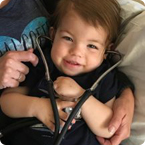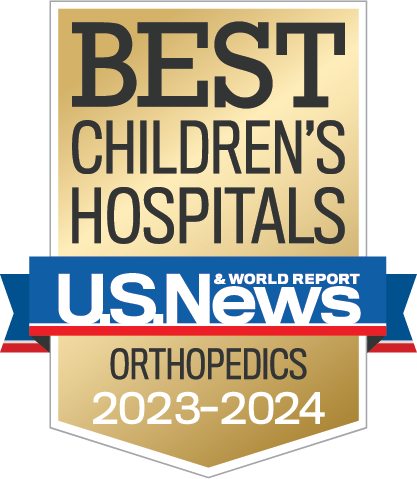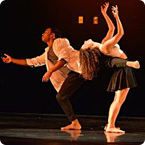Why Choose Us
Caring Experts With Unmatched Experience
- For more than a decade, U.S. News & World Report has consistently ranked our Orthopedics and Sports Medicine Program among the top pediatric orthopedic programs in the country, which means your child will be cared for by the very best.
- Our program takes a comprehensive approach to improving the lives of children with orthopedic conditions by providing high-quality clinical care and a broad range of clinical trial opportunities, while conducting basic science to search for better treatments we can one day offer our patients.
- Seattle Children’s treats the full range of bone, muscle and joint conditions – from the simplest fracture after a fall on the playground to the most complex or rare disorders, like skeletal dysplasia and metabolic bone diseases.
- Many of our pediatric orthopedic surgeons have expanded fellowship training in areas such as foot and ankle conditions, sports medicine, tumors, upper extremity surgery, limb deformity, neuromuscular diseases, skeletal dysplasia and spine problems.
- Our focus is doing what’s best for each family and their unique needs. While our team is comprised of renowned orthopedic surgeons, we do our best to keep children out of surgery whenever possible.
- We’ve helped develop, introduce or refine surgical options that make care better for patients and families, like limb-sparing surgery to reduce amputations in children with bone tumors and the MAGEC (MAGnetic Expansion Control) system to decrease the number of surgeries a child needs for scoliosis.
- To ensure your child receives the best and most safe treatment possible, our team continually evaluates the latest and greatest orthopedic technology available. These technologies often assist our surgeons in achieving optimal surgical outcomes, while also using the lowest amount of radiation possible.
- Our center was founded as an orthopedic hospital over 100 years ago with the vision to help every child, regardless of race, religion, gender or their family’s ability to pay for medical care.
Treatment Designed for Growing Bodies

- Infants, children and teens are still developing, so they may need different care than adults do, like treatment that takes their growth plates into account. Here, your child’s team has special training in the medical, surgical, emotional and social needs of young people.
- We see your child as a whole person. For example, in our Foot and Ankle Deformities Program, we look not only at your child’s feet and ankles, but also their legs, spine, strength, movement, nerves and other features that might play a role in their condition.
- Technologies like the MAGEC system, used to straighten a severe spinal curve, allow us to adjust your child’s treatment as their body grows. This means we can rely less on methods, like spinal fusion, that may limit growth. We have one of the largest growing-rod programs in the country.
- Athletic trainers from Seattle Children’s work at dozens of area schools and many community events. Part of our Sports Medicine Program, they teach conditioning, assess and treat injuries and refer athletes to medical providers, all with an eye to keeping your child active for years to come.
- We have the largest group of board-certified pediatric radiologists in the Northwest. If your child needs imaging that uses radiation, we keep your child’s safety in mind at all times and use the lowest amount possible to produce the best image. We also have a 3D low-dose radiation X-ray machine, called the EOS, for safer full-body 3D images.
Specialists for All Your Child’s Needs
- Complex conditions that affect your child’s bones, muscles and joints may affect other parts of their body too, from their nerves or lungs to their bladder. We connect you with the many types of Seattle Children’s experts your child needs – on the same day, in the same clinic whenever we can.
- Specialized clinics and programs, like the Ortho Rehab Clinic, Bone Tumor and Sarcoma Clinic, Skeletal Health Program, Tone Management Program and Arthrogryposis Clinic, bring together teams of providers to ensure your child receives coordinated care.
- Our orthopedics specialists work closely with specialists from Endocrinology, Genetic Counseling, Neurosciences, Neurodevelopmental, Pulmonary Medicine, Rehabilitation Medicine, Urology, Cancer and Blood Disorders and other departments so your family gets their combined expertise.
- Within Orthopedics, your child is cared for by a team with vast experience, including pediatricians, pediatric orthopedic surgeons, nurse practitioners, physician assistants, nurses, athletic trainers, certified medical assistants, registered orthopedic technologists and sports physical therapists.
Research to Improve Care

- Our program’s expert providers have extensive experience caring for children with complex orthopedics conditions and are involved in numerous international cohorts pioneering research for complex pediatric orthopedic conditions.
- Seattle Children’s doctors take part in research to develop and test new drugs. After studying nusinersen (Spinraza) for spinal muscular atrophy (SMA), we were among the first hospitals in the country to offer it. Orthopedics partners with Rehabilitation Medicine to care for children with SMA.
- Outcomes research helps us know which treatments produce the best results for children. For example, we use tools to ask patients about their function after surgery for limb deformities. Asking children about their experience is essential to improving their lives.
- Some of our research focuses on learning more about diseases that are not yet well understood, like certain forms of dwarfism, and how they progress over time. Our work has helped identify new genes involved in dwarfing, which may lead to new forms of treatment.
- We participate in several registries (databases that collect information about patients who volunteer) so we can collaborate with doctors around the country and the world to better understand orthopedic conditions, such as hand, arm, foot and leg differences.
- Funded in part by the Lynn Taylor Staheli Endowed Chair in Pediatric Orthopedics, our growing research program is discovering better ways to diagnose and care for children.
Here When You Need Us
- For your convenience, our doctors see patients at locations in Seattle, Bellevue, Everett, Federal Way, Olympia, the Tri-Cities, Wenatchee, Yakima and Alaska.
- Children, teens and young adults who need surgery get care at our hospital campus in Seattle.
- The Fracture Program offers a Friday Fracture Clinic to provide dedicated, quick access for children or teens who need evaluation, treatment or follow-up care.
- See our locations and contact information.
Support to Help You Make Treatment Decisions
When Taylor was born with fibular hemimelia, Dr. Vincent Mosca explained two treatment approaches to her parents: multiple surgeries to preserve her foot and lengthen her lower leg or amputation. Together they decided amputating would give Taylor the most active childhood. By age 1, she was learning to ski on her prosthetic leg. As a teen, she became a strong and graceful dancer. Read Taylor’s story and watch her dance.

